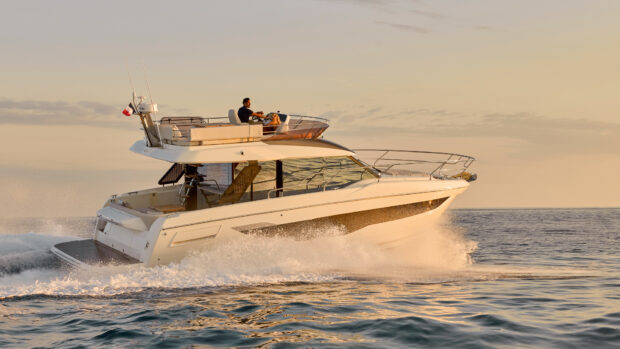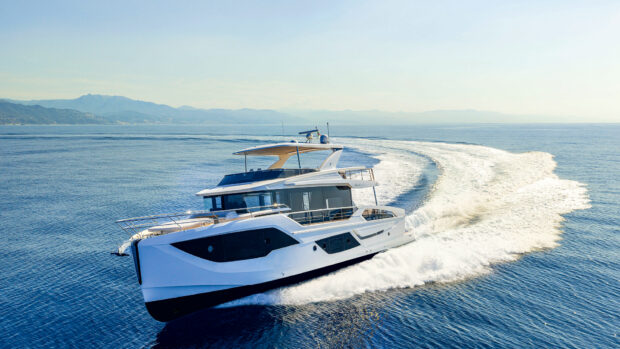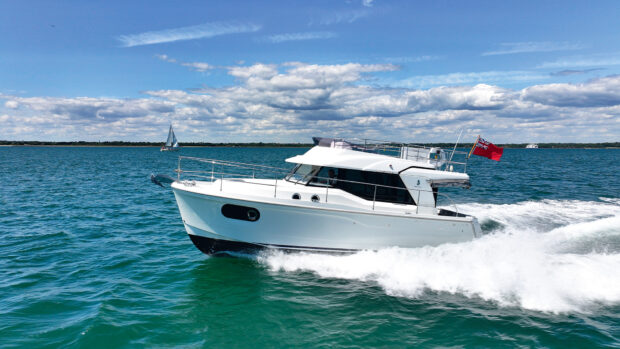Can Leopard’s latest blue-water cruising cat, the Leopard Powercat 40, really excel with just 40ft to play with?
When South African yard, Robertson and Caine, moved into the world of powercats, it went exactly the right way about it. It already had a fleet of Leopard sailing cats that had proven their worth in the charter market, garnering effusive applause from both punters and press. Rather than adapting its existing platforms for power, it resisted the temptation to cheat and set about designing new hulls from the ground up – and so it was that its Leopard range of power cats went on to receive a fresh slew of awards… but can the Leopard Powercat 40 follow in those footsteps?
In 2020, the Leopard Powercat 53 won the Multihull of the Year award. It followed that up two years later with a smaller 46ft version, which also scooped the top gong at the Best of Boats Awards.
And when its smallest powercat completed the hat-trick with the European Powerboat of the Year award in 2024, it became clear that all its hard work and investment was paying dividends.
But can a beamy flybridge-equipped 40ft cruising cat really be as compromise-free as the acclaim suggests? We headed for St Raphael in the South of France to find out.

Given the ratio between length, beam and elevation, the Leopard stylists have done a very decent job here
A big little boat
First thing’s first. The beam on this new Leopard 40 is massive. In fact, at 21ft 8in, it encompasses more than 54% of the overall length, which is way up in sailing cat territory. And interestingly, the vast majority of the internal space that the beam helps create is lavished on the external dayboating zones.
In the absence of a central swim platform, the aft cockpit uses a set of tender davits with a transverse walkway behind the aft bench. Although that involves shunting the aft bench forwards, there’s still space for a set of freestanding chairs.
On first acquaintance, the fixed cockpit table might seem like an odd choice here, but the shelter provided by the vast fly deck means this section of the boat was never intended for sunbathing. On the contrary, if you want to sunbathe, the bow deck is very much the place to be.

The flybridge provides a massive party venue for a boat of this length
Accessed via a set of broad (but not excessively broad) single-level side decks with grabrails for both hands, the bow features a couple of occasional seats built into the forward guardrails, plus a pair of fold-up cushions that rest incongruously against the windscreen.
It’s not likely to impress you much if you’re looking for a conventional bow lounge but there are some truly huge storage compartments here, thanks to the forward dip of the bridge deck, and there’s also a vast acreage of sunbed cushions that would have you believe you’re on a much bigger boat.
Article continues below…

Prestige M48 sea trial review: The smartest multihull on the planet?

Archipelago 47 sea trial review: Brilliant British offshore cat that feels just like home
The flybridge is also absurdly spacious for a platform of this length and, for our money, it’s better used too. The starboard helm features a bench seat that could easily accommodate three people and there’s no need for a reversing backrest because even without it, there’s plenty of room for a large C-shaped dinette. There’s also a chaise longue and wet bar on the port side, plus an open aft deck that’s ideal for a set of freestanding deckchairs.

With the top-end 370hp Yanmars, the new 40 is capable of creaming along at up to 23 knots
Now clearly, on a 40ft boat, something has to take the hit for these big external spaces and the sacrificial zone in this case is the main deck saloon. It looks distinctly short by the standards of the sector but when you step inside, it actually does a remarkably good job.
The sheer breadth in here makes the space feel square rather than long and thin, and the single-level deck, big windows and generous headroom do plenty to augment that sense of scale and openness.
In terms of the layout, the space is broadly split between an aft galley and a forward dinette, with a stairwell on each side to access the cabins. And while plenty of modern cats tend to span the gap between the hulls with a full-beam forward owner’s cabin, the absence of that here means there’s plenty of space for a dedicated door onto the foredeck for a much more natural flow between the various zones.

The saloon might take the hit for the big external spaces but it’s a very attractive zone in
its own right
When you step below, the breadth of those hulls becomes very clear. On the port side, the hull is split in two with a shared bathroom in the centre that operates very naturally as your day heads.
Both cabins get queen-size beds and plenty of storage options, but while the forward cabin is relatively bright and attractive, the aft cabin is the one to grab if you can. It benefits from the deeper sections of hull window as they dip down aft and it also gets a couple of extra windows that look back across the cockpit deck and out over the water.
By contrast, it becomes very clear on the starboard side that this is a privately owned boat rather than a charter model because the entire hull is used for a single open-plan space. Rather sensibly, it mimics the aft bed in the port hull but it replaces the central bathroom with an open-plan dressing area and the forward cabin with a huge bathroom.
There’s plenty of space for two to shower in here and there’s still space beyond the forward bulkhead in the hull’s tapering V for a compartment that will happily swallow a whole batch of bulky suitcases.

If you’re happy to cruise at six knots, you can eke out the range to nearly 900 miles. Hard top solar panels help charge the house batteries
Here, as elsewhere, some of the sliding doors are a bit sticky and awkward but our only real reservation about the interior spaces concerns Leopard’s slightly hardline approach to customisation. For instance, you’ll need to enjoy the test boat’s deck layout because there are no alternatives.
You’ll also need to enjoy the furniture because, for the most part, none of it is convertible or reconfigurable. And then there’s the fact that the relatively dark satin wood finish of the test boat is the only one available. But in the wake of wholesale fanfare for its existing powercat line, there’s a confidence to these design decisions that openly prompts you in how best to use the boat.

Four windows create a very appealing environment at the aft end of the owner’s cabin
If you want to dine, the place for that is the aft cockpit. If you want to sunbathe, the place for that is the bow. And if you want to lounge with a view, the flybridge is where you need to be. If you like the idea of more control, flexibility and customisation potential, there are certainly better boats than this. But if you’re on board with the design solutions to this point, then you need to read on…
How does it drive?
When you first lay eyes on the new 40, nothing about it screams helming dynamism. In fact, with its massive beam, elevated topsides, deepset bridge deck and limited waterline length, you naturally assume that Leopard is more concerned with internal volume than performance.

The port bow cabin gets plenty of privacy thanks to the central heads compartment
But the specialist nature of its powercat underpinnings absolutely shows through when you get it out on the water. In spite of fine angles both at the stem and beneath the waterline, the hulls on this boat are significantly broader than you might expect.
That creates plenty of aft buoyancy to handle the weight of the engines, as well as sufficient forward buoyancy to preserve bridge deck clearance and prevent the swells from impacting on the underside.
That’s not to say this is an especially dry boat because on a day like today, with short choppy seas whipped into aggravated crests by 20-knot gusts, plenty of spray finds its way onto the foredeck, screen and cockpit seating. But it really is just spray.

The skipper gets plenty of company thanks to port companion seating and a bow door as standard
At no point during our sea trial does this boat belly flop; at no point do we feel the unmistakable thud of the bridge deck bottoming out; and not once do we see the high-pressure puff of water at the bow that tends to accompany such impacts.
The ride is gentle, the stability is very good, noise levels are relatively low and the trim of the boat at every point in the rev range is very steady. It all speaks of a boat where the interplay between weight and buoyancy, between volume and softness, is spot on.
As for fuel capacity, 1,400 litres spread across two tanks isn’t especially generous and there’s no option to increase it if you’re a particularly keen long-distance cruise boater, but if you play to this boat’s strengths, the range here actually looks pretty good.
At 9 knots, 500 miles is well on the cards. Push that to 10 knots and the range halves but from here, the diminishing returns level out and everything up to 20 knots delivers a range of between 200 and 250 miles. And if you really need to eke out some extra distance, it’s good to know that dropping the pace to 6 knots will push the envelope way out towards 850 miles.

In fact, in terms of the sea trial element of our day, the only compromise involves the helm itself. While the upper station is very well appointed, the lower helm feels very much like the poor relation.
It’s quite a tight, low-slung affair and because there’s no adjustability at the seat, you find yourself sitting a little deeper than you might choose. You can’t stand up to remedy the situation because the leading edge of the seat prevents you from doing so; and the struts for the screen and forward door also obstruct your view.

As if to drive home the fact that this is very much the secondary helm position, it also uses a single (rather than double) seat with a single (rather than double) plotter – and there’s no control for the bow thruster at the test boat’s lower helm either. Suffice it to say then that Leopard expects you to drive up top – but to help make that a more pleasant experience, it’s good to see that the hard top is supplemented with a set of transparent curtains so you can shut off the entire space and helm in decent comfort when the weather turns.
Leopard Powercat 40 Specifications
LOA: 40ft 0in (12.19m)
BEAM: 21ft 8in (6.61m)
DRAFT: 3ft 7in (1.10m)
DISPLACEMENT: 13,829 kg
FUEL CAPACITY: 1,400 litres
ENGINES: Twin 250-370hp Yanmar diesels on straight shafts
RCD: A8 / B12 / C16
CONTACT: leopardcatamarans.co.uk
Costs & Options
From: £669,000
Test boat includes:
Twin 370hp Yanmars £18,889
Bow thruster £12,580
Shore power pack £9,553
6kw genset £25,857
Flybridge enclosure £10,676
Bow deck cushions £4,482
Price as reviewed:
£829,000.00 As tested ex. VAT
Verdict
In spite of Leopard’s heritage in the charter market, this is a boat that’s likely to carry equal appeal both for first-time buyers and for seasoned cruisers in search of extra space. Certainly, the main deck saloon is moderately sized, the lower helm is imperfect and the options are scant. If you plan on boating in colder climates, the 40’s take-it-or-leave alfresco-centric deck arrangement is also unlikely to float your boat. But in spite of these qualifications, there’s no doubt that this is a very sound piece of work from Leopard. It marries enormous outdoor space with comfortable cruising cabins, massive reserves of storage and a level of seagoing composure that belies its scale and volume. It’s also a boat that commits wholeheartedly to a very specific design direction – and while that will inevitably sour the deal for some, others will find it very tough to see past the new entry point to Leopard’s stellar powercat fleet.










